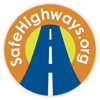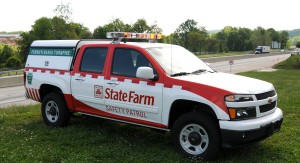 A Partner on the Road
A Partner on the Road
Serving America’s highways with Safety Service Patrols—funded by taxpayers and private sponsors
By Andrew Graham
Across the country, Safety Service Patrols (SSP) travel the highways managing traffic incident scenes, assisting stranded motorists, and improving highway safety. For the past thirty years they have proven to be highly efficient, cost-effective incident management programs. But tight budgets and governmental downsizing have affected many SSP programs. With state and federal funding shrinking or even disappearing, some SSPs have opted to pursue sponsorship opportunities as a new revenue source.
The first SSP sponsor partnership was forged in 2002 in Massachusetts after MassDOT, then MassHighway, retained an agency to secure a sponsor for the state’s 22 vehicle fleet. In the wake of its success, seven other states (Florida, Pennsylvania, Georgia, New York, Kansas, Maryland and Indiana) followed suit. According to a Federal Highway Administration (FHWA) and National Roadway Safety Foundation publication, sponsorship allows states to sustain SSP programs when budget restrictions make it onerous to do so and further permit states to expand in personnel hours and/or coverage area of patrols, as well as new safety patrol vehicles, equipment, and drivers. The publication further states that through sponsorship, “what was previously a significant DOT expense now generates in excess of $30 million for participating states over the term of the current partnerships.”
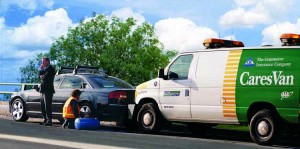
2002 marked the first year of Safety Service Patrol Sponsorship Programs, starting in Massachusetts.
Some states have the ability simply to directly solicit a potential sponsor, but most states are required to follow a public procurement process, resulting in an RFP or ITN. In 2004, “we obtained a contract with an agency that went out and sold the sponsorship on our behalf,” says Mark Beall, Director of Business and Development for Florida’s Turnpike Enterprise. Other states release procurement requests that are directly aimed at sponsors, rather than an agency.
The benefits of sponsorship are enticing to states. Primary, of course, is the money: an infusion of fiscal resources is appealing to budget-strapped programs. In very palpable ways, sponsorship has served as a lifeline for SSP programs. “At a time like this, DOTs are under huge budget constraints; we were looking at cutting the [SSP] program altogether,” says Beall. Sponsorship alone didn’t save the Florida SSP, but it does provide reliable support. And that’s what matters to Beall: “If it adds just one more truck to the program, it’s worth it.”
For the Tampa Hillsborough Expressway Authority (THEA), sponsorship does just that. “One of the many benefits of a local expressway authority is we always place local needs as top priority,” explains THEA Communications Manager, Sue Chrzan, “For the Selmon Expressway, the sponsorship dollars allowed us to keep a Road Ranger on duty to meet those local needs.”
“Years ago, there were times when the shifts weren’t always filled,” Brian Kleinfelter, a State Farm Safety Patrol driver for the Pennsylvania Turnpike Commission adds. “But with State Farm [as the sponsor], someone’s here for every shift, even if it means overtime—that was a stipulation they made. They’ve actually increased the patrols, too; we used to do two patrols per shift, and now we do three.”
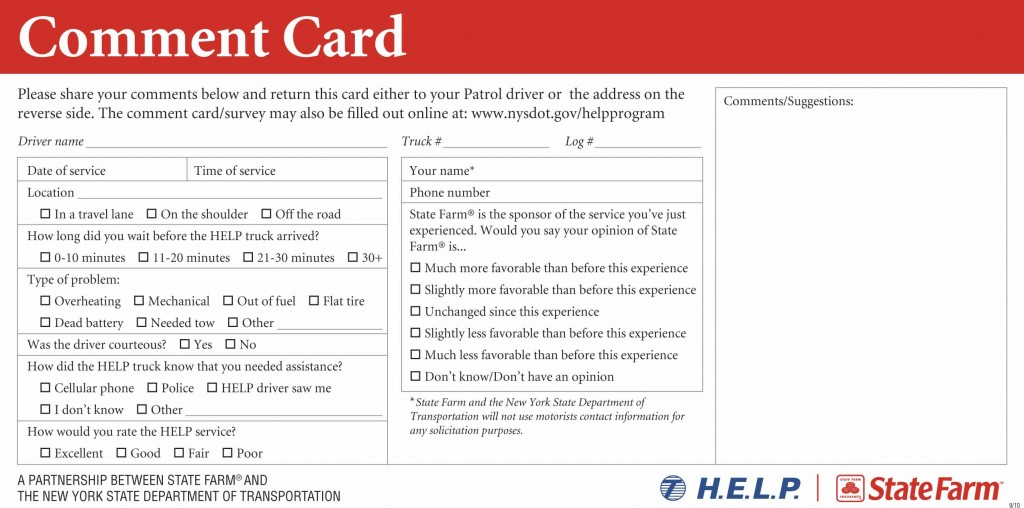
NYSDOT appreciates the sponsor's contribution to the redesign and production of the HELP Program's comment cards.
Similarly, in grappling with the downsizing of his own departmental resources, Drew Scotti, a VP at AutoBase, a firm under contract to NYSDOT to provide HELP (Highway Emergency Local Patrol) services, has found that SSP sponsorship can provide a welcome solution. His vehicles, along with the NYSDOT’s vehicles, are sponsored by State Farm. He cites “[Our] comment cards have been redesigned and are now printed by the sponsor. That has been a huge help, since the loss of our internal NYSDOT Graphic Arts bureau.”
Harvey Heaton, Project Manager at the Hawaii Freeway Service Patrol (FSP), has explored the pros and cons of sponsorship in his current role and in his earlier post as statewide coordinator for the California Highway Patrol’s (CHP) Freeway Service Patrol. Heaton cautions that there are boundaries to be mindful of. “Companies have to be prepared to agree to stipulations as to what the SSP program will allow,” he says. “If an insurance company is providing funds for the badging of trucks or new uniforms, they may want to have drivers hand out promotional brochures for their product. And some programs might just say ‘No’ to that.” But, he notes, “when there are more limitations on state funding, some programs might be more open to that.”
“If a sponsor wants to give a local program some money and say ‘Go use it,’ that’s great,” Heaton continues. “My feeling is that they’re going to want more out of the deal, though. But during the course of negotiations, those things can be worked out so there are no surprises.”
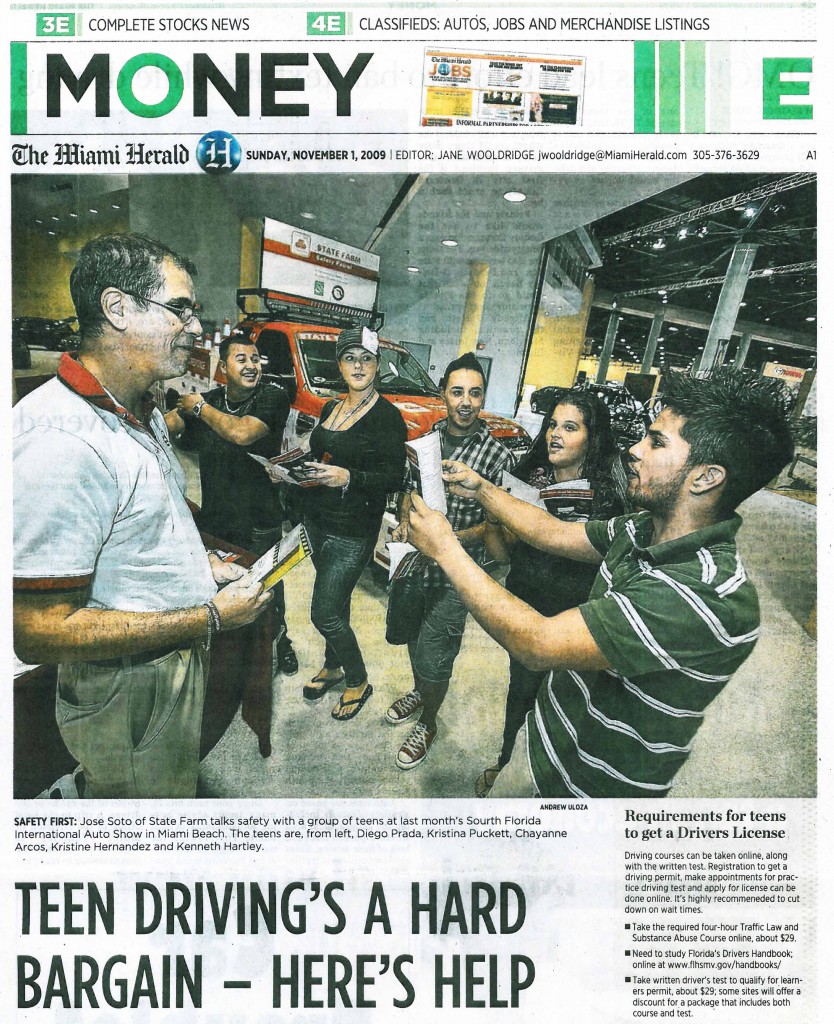
Additional publicity of sponsored Safety Service Patrols benefits both the roadway authority and the sponsor.
Publicity does play a role in SSP sponsorships, for both the state program and the sponsor. Most SSPs don’t have the time or budget for much, if any, program promotion. But when a private sponsor joins the team, there is greater incentive and additional resources to boost awareness and recognition for the program.
Beall appreciates the additional visibility and publicity of the FTE patrol, “There’s an upgrade in image across the program,” Beall says, with increased awareness of the program as a result. “You also get more media attention via the sponsor, which is good for the sponsor and for us—we want our customers to realize the value of the free service we’re providing.”
Autobase’s Scotti shares Beall’s appreciation for sponsorship-driven visibility and publicity improvements. “The reflectivity of the vehicles with the new detailing is fantastic—they are much more visible to the traveling public at night.” Scotti continues, “In addition to the obvious fiscal benefit for New York State, we have found State Farm to be a great resource for information given their sponsorship involvement in other states, and a partner in public outreach.”
And from the sponsor’s perspective, Patrick McDonald, Senior Vice President of Marketing at Mapfre Commerce Insurance, whose company currently sponsors the MassDOT SSP program, appreciates the graphic upgrade to the vehicles. “The MassDOT had vehicles on the road, but they weren’t branded; they were almost unrecognizable. Now, they’re branded, which makes them stand out to drivers.”
“We’ve been doing this for 7-8 years,” McDonald says. “We started with the Commerce Cares Van, which, initially, was a recognizable vehicle—and people just called it the ‘Cares Van’! The Commerce name took a lower priority.” Naturally, the Commerce team (now Mapfre) took steps to establish their brand more effectively.
Some have voiced concerns over changes to core program elements of existing programs. There’s the question of what sponsorship means—where it starts, and where it stops; Sponsorship involves fusing a sponsor’s name and logo and can often lead to the rebranding of a program. As with any contract program or service, it is essential to carefully define the sponsorship scope and thoughtfully negotiate the sponsorship agreement. “Government entities like DOTs can be wary of ‘promoting’ a sponsor,” Heaton says. “They want to be autonomous—rather than having people think, ‘You endorse GEICO,’ for example.”
In the beginning Kleinfelter had similar concerns about maintaining his patrol’s identity. When he and his team were informed their program was going to be sponsored by State Farm, “All we asked was that the re-badging had the Turnpike logo on it, so people wouldn’t think we were auto insurance employees.”

FTE's Beall appreciates the heightened visibility and new look of the sponsored Road Rangers patrol.
In contrast, Florida’s Mark Beall found the rebranding to be a benefit. “We went from generic white pickup trucks, with ‘Road Rangers’ on them in black print,” says Beall, “to being able to give our trucks much more eye-catching designs. I think it gives the trucks a greater presence on the road; it enhances the image of the program and makes it more noticeable to the general driving public.”
Indiana DOT’s Hoosier Helpers program was also able to re-badge its fleet of trucks, jointly featuring the program’s name along with its sponsor’s logo, and they installed 25 highway signs where previously there were none. Mike Bowman, Director of Traffic Support for the INDOT, appreciates the level of freedom the partnership provides: “The sponsor provides support,” he says, “but they don’t run our program.”
Indiana’s Bowman values the benefits afforded to the INDOT Hoosier Helpers through sponsorship. Heaton, on the other hand, remains wary. “In California,” Heaton says, “we resisted sponsorship. We had concerns about setting a precedent; if you allow an insurance company to sponsor a truck, that’s one thing—but what other potential sponsors would you not allow? If an undesirable sponsor approached you with money in hand, can you deny them?” Heaton feels it is an important question to consider.
While CVS is a sponsor of a few of the Samaritania programs, auto insurance companies are currently the primary sponsors of SSPs. Mapfre Commerce’s McDonald says, “This is a way for us to give back to our customers, in an environment that’s close to our industry.”
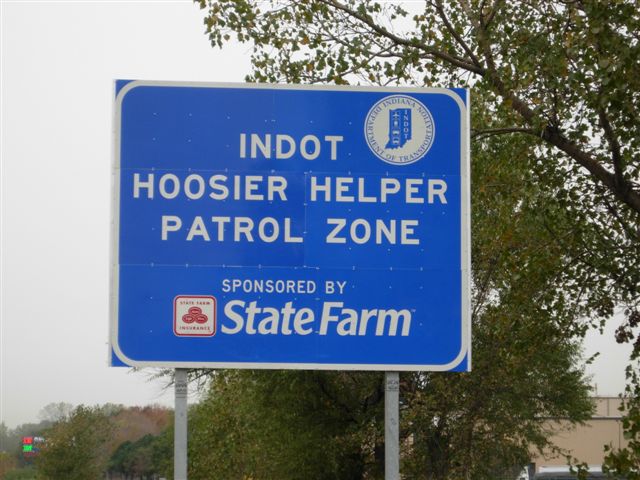
As part of the sponsorship program, INDOT Hoosier Helpers installed 25 informative highway signs along covered routes.
McDonald sees SSP programs not just as a marketing opportunity, but as a three-way partnership. “We’re an insurance company,” he says. “Naturally, helping prevent accidents and save lives helps us a great deal. But [SSP programs] don’t generate revenue for the state, so in these days of budget cuts, they would be among the first to go. So, it’s really win-win-win—for the DOT, the sponsor and the taxpayer.”
Kleinfelter agrees; under the sponsorship agreement, his patrol program has been able to grow and improve. “They’re listening to us and asking us what we need. We’ve gotten better equipment for our trucks—red lights, sirens, and so on. It all helps us respond quicker.”
Scotti also views SSP sponsorship as a logical direction for both private and public organizations to explore. “It is becoming more common for states and other agencies to begin looking to private industry for sponsorship opportunities.” He, too, acknowledges that the “FHWA supports the idea of sponsorship, and more people are starting to realize the successes agencies [DOT’s and turnpike authorities] are having with it.”
In fact, on November 15, 2011, the Federal Highway Administration and the Roadway Safety Foundation honored “Safety Patrol Sponsor-Partnerships” with the 2011 National Roadway Safety Award. The partners recognized for this award included state departments of transportation in Massachusetts, Florida, Georgia, New York and Maryland as well as turnpike authorities in Florida, Pennsylvania and Kansas.
Representing one of the winners, Chrzan appreciates the support from the FHWA and Roadway Safety Foundation. “Tampa Hillsborough Expressway Authority is honored to have our successful partnership with State Farm nationally recognized.”
The award was given in recognition of the Safety Service Patrol Sponsorship Program’s role in making the country’s roads and highways safer—and saving lives. In an official statement, Jon Porcari, Deputy Secretary of the U.S. Department of Transportation, said, “Each one of this year’s entries demonstrated a commitment to saving lives by improving our nation’s roadways.” Executive Director of the Roadway Safety Foundation, Greg Cohen, continued “These awards are an opportunity to thank those who increase our odds of getting home safely each day.”
Sponsorship is a benefit that SSPs are increasingly embracing in an unstable economic climate. For Indiana DOT’s Bowman, it’s a simple equation: additional financial support equals better service. “We provide roadside assistance for flat tires and empty tanks—but we also provide immediate first aid. We’re often the first ones at an incident. And if you prevent a few fatalities a year, it’s worth it,” explains Bowman. “Times are hard; everyone’s trying to steal everyone’s budgets. I may not be able to grow the program, but not having to downsize it? That’s a win.”
